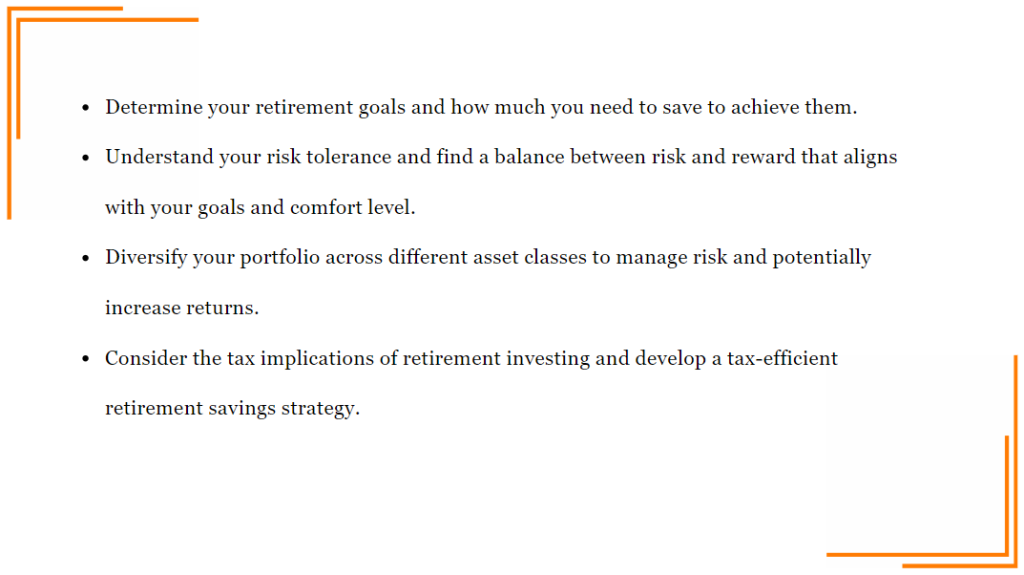Retirement investment refers to investing money to generate income or capital gains to support one’s retirement. Retirement investing typically involves investing in a mix of asset classes, including bonds, real estate, and stocks, intending to achieve long-term growth and income.
Retirement investing primarily aims to build a nest egg that can provide income and financial security during retirement. Retirement investing can involve investing in employer-sponsored retirement plans, such as 401(k)s or 403(b)s, in addition to personal retirement accounts (IRAs) and other investment vehicles.
Retirement investing requires careful planning and consideration, and in developing comprehensive retirement savings, it’s crucial to have a strategy that fits your objectives and risk tolerance. By investing wisely and staying committed to your retirement savings plan, you can build a solid nest egg to help you achieve your long-term financial goals.
Key Takeaways

How Vital Is Retirement Investment?

Retirement investing is essential for several reasons:
Long-term financial security: Retirement investing allows individuals to build a financial cushion to support their lifestyle during retirement. By investing in assets that can generate income or appreciate over time, individuals can create a source of funds to sustain them during their retirement.
Inflation and rising costs: Investing in retirement helps individuals combat the impact of inflation and rising living costs. By investing in assets that have the potential to outpace inflation, individuals can protect the purchasing power of their savings over the long term.
Supplementing retirement income: Retirement investing allows additional income streams beyond traditional retirement benefits, such as Social Security or pensions. This can help individuals maintain their standard of living and pursue their desired lifestyle during retirement.
Legacy and estate planning: Retirement investing can also encompass estate planning, allowing individuals to manage and distribute their assets according to their wishes, providing for loved ones, and leaving a legacy.
Overall, retirement investing is crucial for individuals to build a financial foundation that supports their long-term financial goals, provides security during retirement, and helps them navigate the economic challenges that come with aging.
Four Things You Must Know When Retirement Investing
Here are four things you must know when retirement investing:
1. Your Retirement Goals

It’s essential to have a clear understanding of your retirement goals and how much you need to save to achieve them. This will help you determine how much you need to keep each year and what types of investments are best suited for your needs.
The “best” retirement goals are personalized and tailored to an individual’s unique circumstances, aspirations, and financial situation. There is no one-size-fits-all answer to what constitutes the best retirement goals, as they are highly subjective and dependent on individual preferences and needs.
However, some common elements of practical retirement goals may include:
Financial security: Having a steady income or sufficient savings to cover living expenses, healthcare costs, and potential emergencies during retirement.
Lifestyle choices: Pursuing activities and experiences that bring fulfillment and joy, such as travel, hobbies, or spending time with family and friends.
Healthcare needs: Planning for potential medical expenses and long-term care, ensuring access to quality healthcare services.
Legacy planning: Considering how assets will be managed and distributed, including providing for loved ones and charitable giving.
Flexibility: Allowing for adjustments to retirement goals as circumstances change, such as health, family dynamics, or economic conditions.
The best retirement goals are well-defined, realistic, and aligned with an individual’s values and priorities. Individuals must assess their financial situation, envision their desired retirement lifestyle, and develop a comprehensive plan to achieve their goals. Seeking professional financial advice can also be beneficial in setting and working towards these goals.
2 . Your Risk Tolerance

Your risk tolerance is essential when investing in retirement. Finding a balance between risk and reward that aligns with your goals and comfort level is necessary.
Factors influencing risk tolerance in retirement investing include:
Time horizon: As individuals near retirement, their time horizon for investment growth and recovery from potential losses may shorten, leading to a lower risk tolerance.
Financial stability: Assessing your financial situation, including income, savings, and other assets, can help determine how much risk you can afford to take with your retirement investments.
Emotional response: Understanding your comfort level with market volatility and potential investment losses is crucial. Some individuals may feel anxious or stressed during market downturns, while others may be more comfortable with fluctuating investment values.
It’s essential to align your retirement investment strategy with your risk tolerance to ensure your portfolio reflects your comfort level with market fluctuations. Working with a financial advisor can help you assess your risk tolerance and develop an investment strategy that suits your needs and goals, considering the specific considerations related to retirement investing.
3. Diversification

Diversification is critical to managing risk in your retirement portfolio. By investing in a mix of asset classes, such as stocks, bonds, and real estate, you can reduce the impact of market volatility on your portfolio and potentially increase returns.
Diversification in retirement investing involves spreading your investment funds across a variety of asset classes, such as stocks, bonds, real estate, and potentially alternative investments, to help manage risk and improve returns. This strategy aims to reduce the impact of market volatility on your retirement portfolio by not being overly reliant on the performance of a single investment or asset class.
The benefits of diversification in retirement investing include:
Risk management: Diversifying your retirement portfolio can help mitigate the impact of market downturns on specific assets. When one asset class underperforms, others may provide stability or growth, reducing overall portfolio risk.
Growth potential: By investing in different asset classes, you can benefit from the growth potential of various sectors and markets, improving overall portfolio returns.
Income generation: Diversification can provide a mix of investments that generate income, such as stock dividends or interest from bonds, helping support your retirement income needs.
Adaptability: As retirement approaches, a diversified portfolio can be adjusted to reflect changing risk tolerance and income needs, providing flexibility as retirement goals evolve.
It’s important to note that diversification does not eliminate the risk of investment losses, but it can help manage and spread risk across different assets. Working with a financial advisor can help you develop a diversified retirement investment strategy that aligns with your risk tolerance, financial goals, and time horizon.
4. Tax implications

Tax implications play a significant role in retirement investing, as they can impact the growth and distribution of retirement savings. Here are some key tax considerations in retirement investing:
Tax-deferred retirement accounts: Contributions to traditional IRAs, 401(k)s, and similar retirement plans are typically made with pre-tax dollars, allowing for tax-deferred growth of investments. However, withdrawals in retirement are generally subject to income tax, potentially affecting the funds available for retirement income.
Roth retirement accounts: Roth IRAs and Roth 401(k)s are funded with after-tax dollars, and qualified withdrawals in retirement are generally tax-free. Utilizing Roth accounts can provide tax-free income in retirement and may offer tax diversification in retirement planning.
Required minimum distributions (RMDs): Traditional retirement accounts are subject to RMDs starting at age 72, which require account holders to withdraw a minimum amount each year, subject to income tax. Failing to take RMDs can result in substantial penalties.
Tax-efficient investment strategies: Consideration of tax-efficient investment strategies, such as holding tax-advantaged investments in taxable accounts and tax-inefficient investments in retirement accounts, can help manage tax liabilities.
Capital gains and dividends: Taxable investment accounts may generate capital gains and dividends, subject to capital gains tax and income tax, respectively. Managing investments to minimize tax impact is essential for retirement income planning.
Understanding the tax implications of retirement investing is crucial for maximizing retirement income and managing tax liabilities. Collaborating with a tax specialist or financial advisor can help individuals navigate the complexities of retirement tax planning and develop strategies to optimize tax efficiency in retirement investing.
How Much Should You Save for Retirement?

The amount you need to save for retirement depends on various factors, including your desired retirement lifestyle, expected longevity, healthcare costs, and other financial obligations. While there is no one-size-fits-all answer, here are some steps to help estimate how much you need to save for retirement:
Assess your retirement goals: Consider the lifestyle you envision during retirement, including travel, hobbies, and other activities. This can help you estimate your retirement expenses and income needs.
Calculate retirement expenses: Estimate your annual expenses, including housing, healthcare, food, entertainment, and other costs. Consider potential healthcare expenses, as they often increase in retirement.
Determine retirement income sources: Determine possible retirement income sources, such as pensions and Social Security., and other benefits. Understanding your projected retirement income can help assess how much you need to save to bridge income gaps.
Use retirement calculators: Online retirement calculators can help estimate the amount you need to save for retirement based on current savings, expected retirement age, life expectancy, and investment returns.
Consider inflation and longevity: Account for and potential longevity when estimating retirement savings. A more extended retirement period and the impact of inflation can significantly affect the amount needed for retirement.
Consult a financial advisor: Seeking guidance from a financial advisor can provide personalized insights into retirement savings goals, investment strategies, and retirement income planning.
While the specific amount needed for retirement varies for each individual, carefully considering retirement goals, expenses, income sources, and financial planning tools can help estimate the savings required to support a comfortable and secure retirement.
What is the best Age to retire

The best Age to retire is a highly individual decision that depends on various factors, including personal preferences, financial readiness, health considerations, and lifestyle goals. There is no one-size-fits-all answer, as the optimal retirement age can vary significantly from person to person. Here are some factors to consider when determining the best Age to retire:
Financial readiness: Evaluate your retirement savings, investment income, Social Security benefits, and additional retirement income streams to ensure that you have sufficient funds to support your desired lifestyle throughout retirement.
Health considerations: Consider your overall health and potential healthcare needs in retirement. Some individuals may retire earlier to enjoy good health and pursue personal interests, while others may prefer to work longer to maintain employer-sponsored health benefits.
Longevity: Assess your life expectancy and consider how many years of retirement you may need to fund. Retiring too early can result in a more extended retirement period, potentially requiring more substantial retirement savings.
Social Security benefits: The Age at which you decide to begin getting Social Security benefits can affect the amount of your monthly payments. Delaying Social Security can result in higher monthly benefits while claiming benefits early can reduce prices.
Lifestyle goals: Consider your retirement aspirations, such as travel, hobbies, volunteer work, or spending time with family. Your retirement age should align with your goals and aspirations for this stage of life.
Career satisfaction: Some individuals may continue working beyond the traditional retirement age if they find fulfillment in their careers or wish to pursue encore careers, part-time work, or consulting opportunities.
Ultimately, the best Age to retire is a personal decision that should be carefully considered in light of your financial situation, health, goals, and overall life circumstances. Seeking guidance from a financial advisor or retirement planner can assist you in making wise choices. And develop a retirement plan that aligns with your needs and aspirations.
Use a taxable account for retirement savings?

Using a taxable account for retirement savings can be a viable strategy, especially for individuals who have maximized contributions to tax-advantaged retirement accounts such as 401(k)s, IRAs, and similar plans. Here are some considerations regarding using a taxable account for retirement savings:
- Flexibility: Unlike tax-advantaged retirement accounts, taxable accounts do not have contribution limits or restrictions on when funds can be withdrawn. This adaptability may be helpful for those looking to save additional funds for retirement beyond the boundaries of traditional retirement accounts.
- Tax treatment: While contributions to taxable accounts are made with after-tax dollars, investment earnings in these accounts are subject to capital gains tax. However, qualified dividends and long-term capital gains are often taxed at lower rates, providing some tax advantages for investments in taxable accounts.
- Access to funds: Funds in taxable accounts can be accessed at any time without penalties, making them suitable for individuals needing to tap into their savings before traditional retirement age.
- Diversification: Including taxable accounts in retirement planning can provide tax diversification, allowing retirees to manage their tax liabilities by choosing which accounts to withdraw funds from based on their tax situation.
- Estate planning: Taxable accounts can be part of an estate planning strategy, providing flexibility for asset passing to heirs and beneficiaries.
While taxable accounts offer flexibility and tax advantages for specific investments, they may not provide the same tax benefits as traditional retirement accounts. Considering the overall tax implications and investment strategies when incorporating taxable accounts into retirement savings is essential. Speaking with a financial counselor or tax professional can help individuals evaluate the role of taxable accounts in their retirement planning and develop a comprehensive strategy that aligns with their financial goals.
Smart Retirees Do This With Their Money – Simple and Effective Retirement Planning Strategy
A simple and effective retirement planning strategy begins with early and consistent savings, taking advantage of the power of compounding over time. Setting clear retirement goals, diversifying investments across various asset classes, and regularly monitoring and adjusting your retirement plan ensures you are well-prepared for the future. Seeking professional advice from a financial advisor can further enhance your retirement planning strategy, ensuring it is tailored to your needs, risk tolerance, and long-term objectives. By following these steps, individuals can build a strong foundation for a secure and comfortable retirement.
What are The Best Retirement Investing Accounts?

The best retirement investing accounts often include tax-advantaged options that offer various benefits for long-term savings. Some of the most commonly recommended retirement investing accounts are:
401(k) Plans: Employer-sponsored 401(k) plans allow employees to make a pre-tax income contribution, with potential employer matching contributions. These contributions grow tax-deferred until withdrawal during retirement.
Individual Retirement Accounts (IRAs): Traditional and Roth IRAs offer tax advantages for retirement savings. Traditional IRAs provide tax-deferred growth, while Roth IRAs offer tax-free withdrawals in retirement, subject to certain conditions.
Simplified Employee Pension (SEP) IRA: SEP IRAs are intended for independent contractors and small business owners, providing a tax-favored retirement savings plan.
403(b) Plans: Similar to 401(k) plans, 403(b) plans are offered by public schools and specific tax-exempt organizations, providing employees with a tax-advantaged way to save for retirement.
Health Savings Accounts (HSAs): While primarily intended for healthcare expenses, HSAs can also serve as retirement investment vehicles. Tax deductions are available for contributions, and withdrawals for approved medical costs are tax-free. After age 65, non-medical withdrawals are subject to income tax.
Deferred Annuities: Deferred annuities are insurance products that provide a guaranteed income stream in retirement. They offer tax-deferred growth and can be used to supplement other retirement accounts.
An individual’s best retirement investing accounts will rely on elements like employment status, income level, tax situation, and retirement goals. It’s critical to consider these things and speak with a financial advisor to determine the most appropriate retirement investing accounts for your needs.
Best Passive Income Ideas For Beginners With No Money
Passive income can be a valuable source of additional earnings, offering financial flexibility and the potential to build long-term wealth. Rental properties can be a promising option for beginners looking to explore passive income opportunities. Investing in real estate and renting out properties, whether a spare room, a vacation property, or a rental unit, can provide a steady stream of passive income through rental payments. While initial investment and management are required, the potential for consistent cash flow makes rental properties an attractive passive income idea for those willing to take on the responsibilities of property ownership.
Another accessible passive income idea for beginners is dividend stocks. By investing in dividend-paying stocks, individuals can earn regular income. Many established companies offer dividends to shareholders, providing a reliable source of passive income. With careful research and a long-term investment approach, dividend stocks can be a relatively low-maintenance way for beginners to generate passive income from the stock market. As with any investment, conducting thorough research and seeking professional advice is essential to ensure that the chosen passive income idea aligns with individual financial goals and risk tolerance.
Frequently Ask Questions
Certainly! Here are some frequently asked questions (FAQs) on retirement investing, along with their answers:
What is retirement investing, and why is it important?
Answer: Retirement investing involves setting aside funds and making strategic investment decisions to build a financial cushion for retirement. It is essential to ensure a secure and comfortable retirement lifestyle.
What are the critical differences between retirement investing and other types of investments?
Answer: Retirement investing focuses on long-term goals, such as generating income during retirement, preserving capital, and managing risk, whereas other types of assets may have different time horizons and objectives.
How can I determine my risk tolerance for retirement investing?
Answer: Risk tolerance can be determined by considering investment time horizon, financial goals, and emotional comfort with market fluctuations.
What are the tax implications of retirement investing, and how can I optimize tax efficiency?
Answer: Retirement investing can have tax implications for contributions, withdrawals, and investment earnings. Optimizing tax efficiency may involve using tax-advantaged retirement accounts and tax-efficient investment strategies.
What are the potential impacts of inflation on retirement investments, and how can I plan for it?
Answer: Inflation can erode the purchasing power of retirement savings over time. Planning for inflation involves investing in assets that have the potential to outpace inflation and considering cost-of-living adjustments in retirement income.
What are the various retirement investment vehicles available, and how do they differ?
Answer: Retirement investment vehicles include 401(k)s, IRAs, Roth accounts, annuities, and taxable investments. Each has unique tax treatment, contribution limits, and withdrawal rules.
How does diversification play a role in retirement investing, and how can it help manage risk?
Answer: Diversification involves spreading investments across different asset classes to manage risk. It can reduce the impact of market volatility on a retirement portfolio.
What are the best practices for creating a retirement investment portfolio?
Answer: Best practices include setting clear retirement goals, diversifying investments, periodically reviewing the portfolio, and adjusting the asset allocation based on changing circumstances.
How can I assess my retirement savings goals, and what tools are available to help with this process?
Answer: Retirement savings goals can be set by estimating retirement expenses, evaluating potential income sources, and using retirement calculators to determine the amount needed for retirement.
What are the implications of retiring early or late, and how does it affect retirement investing
Conclusion
In conclusion, understanding the four critical aspects of retirement investing is crucial for building a solid financial foundation for retirement. Assessing and aligning your risk tolerance with your investment strategy ensures you can pursue growth while safeguarding your savings from market volatility. Additionally, being mindful of the tax implications associated with retirement investment vehicles allows you to optimize your savings and income, ultimately maximizing the benefits of your retirement funds.
Planning for inflation is equally essential, as it helps protect your purchasing power over time, ensuring that your retirement savings can sustain your lifestyle in the face of rising living costs. Finally, diversifying your investments across various asset classes can help manage risk and potentially enhance long-term returns, providing a balanced approach to achieving your retirement goals.
By considering these key factors, individuals can make informed decisions and develop a comprehensive retirement investment strategy. This approach allows for the effective management of risk, tax optimization, and protection against the erosive effects of inflation, ultimately contributing to the long-term sustainability of retirement savings. Embracing a diversified investment portfolio further bolsters financial resilience, potentially enhancing the ability to meet retirement income needs and maintain financial security throughout the retirement years. Overall, a well-rounded understanding of these essential elements of retirement investing is necessary for building a solid financial footing and pursuing a comfortable and secure retirement.

Related Training Program
What is the Wealth Building Way Academy
Learn More about Wealth Building Way here: Click Here Now!
The Wealth Building Way Academy is a Free Video Training
Course Available only to our Readers and Subscribers. Its
A thorough and detailed training available to you. Find
out more about it here. Click and Learn.
Related Articles
- The Technical Traders – Recent Insights and Analysis Roundup
- How to Pay Your Way Through College Trading Stocks
- 10 Proven Ways to Boost Your Retirement Income
- How To Make Money In Stock Market For Beginners
- How to Make Money in Stocks


Announcing Your New 21st Century

Dear Trader,
Follow me on what could be the most exciting and rewarding adventure of your life!
“I guess you could call it a hobby for me because I do enjoy doing it.
But it’s also a job, because it provides an income source. So it’s a job
that I enjoy doing. And it can be very exciting.”
Dr. Jack, Hilton Head, SC –Retired Optometrist
“For me it’s income in excess of $150,000 a year… Spending just a
few minutes a day… And I can do it right on my phone from just
about anywhere!”
Craig F., Central CA — Retired Program Director
“I’m averaging over $10,000 a month. We went on cruises to Nova
Scotia, the Mediterranean, Alaska… And I was able to help two of my
children buy homes. We couldn’t have done this before.”
Rod W., Atlanta, GA Retired Pharmacist
Health, wealth, and happiness go hand-in-hand…
Click here to find out how you can potentially ignite all three!
Sincerely,

Chuck Hughes
PS Imagine if it were possible for you to enjoy a 6-figure income… PLUS
increased mental & physical vitality well into your ‘90s… CLICK HERE





